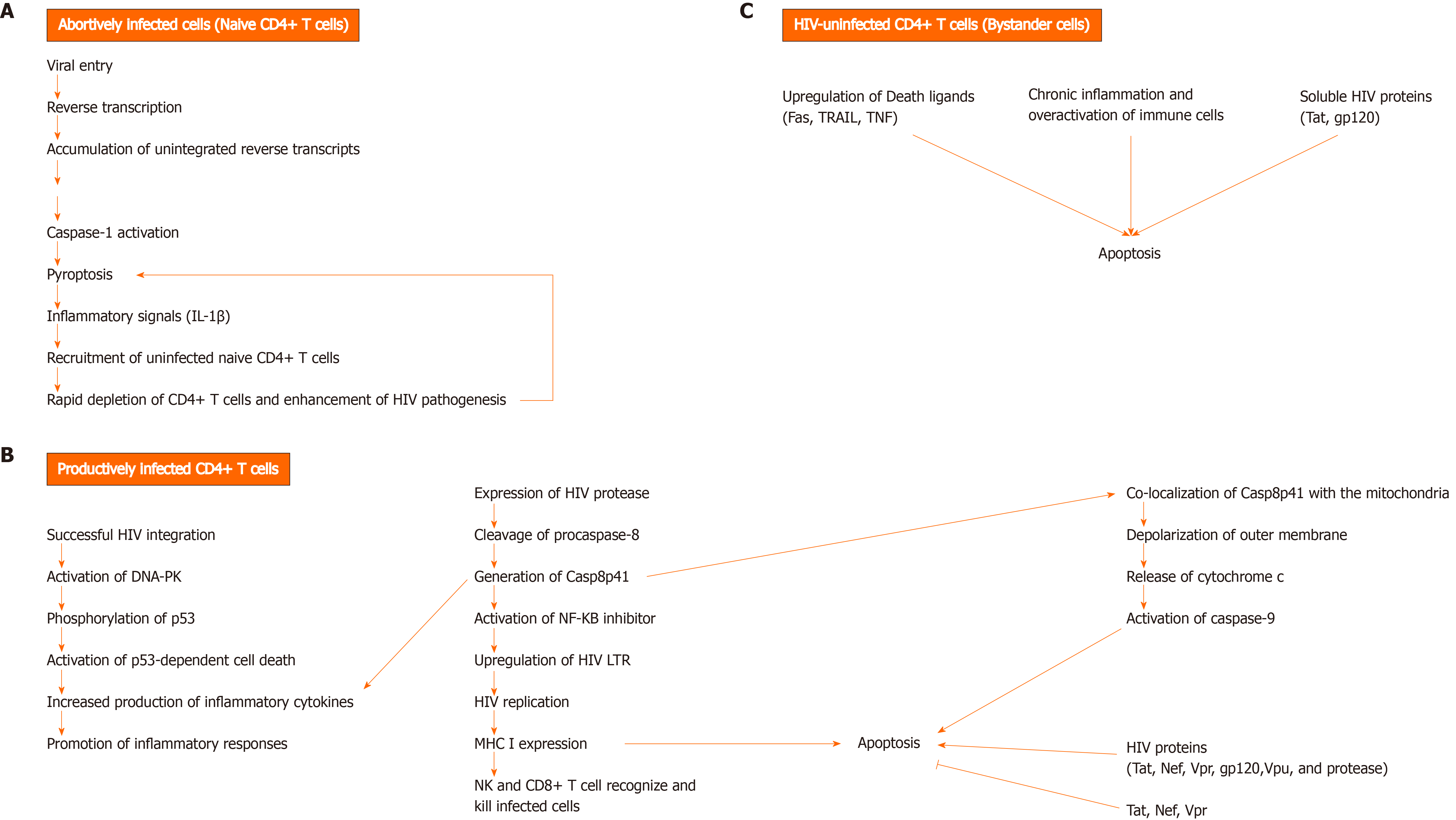Copyright
©The Author(s) 2021.
World J Gastrointest Pathophysiol. Jul 22, 2021; 12(4): 59-83
Published online Jul 22, 2021. doi: 10.4291/wjgp.v12.i4.59
Published online Jul 22, 2021. doi: 10.4291/wjgp.v12.i4.59
Figure 1 Mechanisms of CD4+ T cell death during human immunodeficiency virus infection.
A: Unsuccessful human immunodeficiency virus (HIV) infection can lead to HIV-infected CD4+ T cell death by pyroptosis, an inflammatory programmed cell death that occurs via caspase-1 activation. As a result, inflammatory signals, such as Interleukin-1β are released. The accumulation of unintegrated reverse transcripts, following viral entry and reverse transcription, can indirectly activate caspase-1 and induce pyroptosis in resting CD4+ T cells with abortive viral infection. Pyroptosis is thought to greatly contribute to the rapid depletion of CD4+ T cells and development of chronic inflammation, as a result of proinflammatory cytokine release from dying CD4+ T cells, which in turn causes the recruitment of uninfected and naïve CD4+ T cells into the lymphoid tissues. These cytokines trigger pyroptosis in the recruited cells, leading to a vicious cycle of inflammation, thereby enhancing HIV pathogenesis by creating an overactive immune environment and further cell death; B: Cell death can occur in productively infected CD4+ T cells, following successful HIV integration and expression of HIV protease (PR). HIV PR can cleave cellular procaspase-8 and generate Casp8p41. This fragment activates the transcription factor NF-kappaB inhibitor and thus, induces HIV replication by upregulating HIV long terminal repeats (LTRs). Casp8p41 expression promotes inflammatory responses by enhancing the production of pro-inflammatory cytokines. Besides, Casp8p41 induces apoptosis by directly co-localizing with the mitochondria and depolarizing its outer membrane. The subsequent release of cytochrome c from mitochondria leads to activation of caspase 9 and cell death. Another mechanism by which viral integration triggers cell death is through the activation of deoxyribonucleic acid-dependent protein kinase, resulting in phosphorylation of p53 and activation of p53-dependent cell death program. HIV Tat, Nef, and Vpr can have both pro- and anti- apoptotic effects. On the other hand, gp120, Vpu, and protease have pro-apoptotic effects. HIV-infected cells can be killed by cytotoxic lymphocytes, natural killer cells and CD8+ T cells, which become highly active during infection; C: HIV-uninfected cells, known as bystander cells, usually die by apoptosis during the course of infection, due to either: upregulation of death ligands (Fas, TRAIL, TNF), activation-induced cell death due to chronic inflammation and over activation of immune cells, or direct cytotoxic effects of soluble HIV proteins (Tat, gp120). DNA-PK: DNA-dependent protein kinase.
- Citation: Al Bitar S, Ballouz T, Doughan S, Gali-Muhtasib H, Rizk N. Potential role of micro ribonucleic acids in screening for anal cancer in human papilloma virus and human immunodeficiency virus related malignancies. World J Gastrointest Pathophysiol 2021; 12(4): 59-83
- URL: https://www.wjgnet.com/2150-5330/full/v12/i4/59.htm
- DOI: https://dx.doi.org/10.4291/wjgp.v12.i4.59









